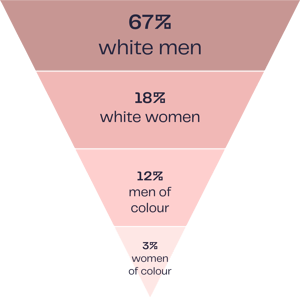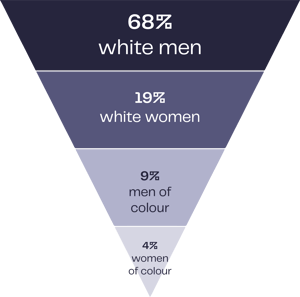International Women’s Day is here again. That day where companies big and small compete over who can shout the loudest about their commitment to diversity.
But here’s the thing.
Companies make all the right noises, and there have been some cool, and successful, initiatives (like PwC’s Shadow a Female Leader scheme).
But at macro-scale, nothing much changes.
Still, women earn more degrees than men and still, more men than women are hired and promoted. Progress is agonizingly slow.
It’s time for real change. Cultural change. Cultural change that starts the moment new hires sign your employment contract.
Here’s how.
Statistics That Prove Diversity Matters
Let’s set the scene quickly first (thanks, McKinsey). Skim ahead if you’re already down with the business case for diversity. (Or, hey, forward to a colleague who hasn’t yet seen the light.)
Diversity matters because:
- Globally, companies in the top quartile for racial and ethnic diversity are 35% more likely to financially outperform their peers.
- Globally, companies in the top quartile for gender diversity are 15% more likely to financially outperform their peers.
- In the UK, every 10% increase in gender diversity on the senior exec team leads to earnings before interest and taxes (EBIT) increase of 3.5%.
- In the US, every 10% increase in racial and ethnic diversity on the senior exec team leads to EBIT increase of 0.8%.
But there’s still a huge distance to go. Both for gender diversity:
- In the US, only 16% of executive team members are women
- In the UK, only 12% of executive team members are women
- In Brazil, only 6% of executive team members are women
And for racial diversity:
- In the UK, 78% of senior leadership teams fail to reflect the country’s demographic composition
- In Brazil, 91% of senior leadership teams fail to reflect the country’s demographic composition
- In the US, 97% of senior leadership teams fail to reflect the country’s demographic composition
McKinsey’s Women in the Workplace 2017 report analyzed the corporate pipeline and found C-Suite members were:

Those ratios are similar at every level, from entry level upwards. And the trend continued in the Women in Workplace 2018 report.
C-Suite members last year were:

It’s little wonder that 75% of global employees say their company’s diversity program simply isn’t effective.
The fact is, companies make all the right noises about diversity – but little has changed. Progress is practically non-existent.
So let’s fix that.
Onboarding is fundamental to diversity and inclusion
Building a more diverse workforce isn’t just about hiring and promoting more women or people of color. It’s not about hollow quotas.
It’s about taking decisive steps to build an inclusive culture. So people from diverse backgrounds are supported, empowered and inspired to realise their full potential with you.
Building an inclusive culture starts from the moment you hire. It’s very difficult to change a first impression, so inclusivity has to start from pre-onboarding onwards.
Here’s how to embed inclusivity into onboarding. So new hires from diverse backgrounds are better placed to thrive.
1
Co-create benefits
Harvard Business Review’s recent global diversity survey uncovered a worrying truth. There’s a significant gap between the benefits women want, and the benefits men think are important.
Which is a real problem, when the overwhelming majority of senior decision-makers are men.
Consider:
- Women rank parental leave 3rd most important, but men rank it 10th
- Women rank healthcare 6th most important, but men rank it 11th
- Women rank childcare support 11th most important, but men rank it 22nd
Reassessing your benefits program is an obvious first step – as long as you ensure diverse voices contribute to the conversation.
Read more: The five most coveted employee benefits
But even better, create a culture where everyone’s voice matters from the moment you hire them. Embed the benefits conversation into your onboarding process, so you don’t just dictate what you offer but you ask new hires what they need.
Consider building a flexible portfolio of benefits for employees to choose from, so your people co-create their role so it meets their needs. So they can meet yours more effectively.
The fact is, today’s workplace has changed dramatically. HR leaders must find new ways to inspire and engage their people. Flexible benefits are a step in the right direction.
2
Tailor your onboarding process
Onboarding gives new hires everything they need to hit the ground running. But different hires will need different things to achieve that goal.
Which is intuitive, when we talk about seniority. You might send your new marketing executive a pack defining business-casual, for example, while your new CFO cares more about getting to grips with last year’s revenue metrics.
And it’s still pretty obvious when we talk about tenure. Your new Sales Director should get comprehensive onboarding from the moment she signs and months beyond. Your temp receptionist doesn’t need anywhere near the same depth.
But tailoring your onboarding process is equally important down gender and diversity fault-lines.
Like, many businesses record a welcome message from the CEO. But, given your CEO is likely a white male, why not create a welcome video from a female leader to welcome your new female hires?
And think about ways to tailor content. FAQs, for example, are likely quite different for men versus women. The idea is to send a strong message to new hires that you care about their unique experience.
Ask majority and minority representatives to share ownership for creating onboarding content, so no hidden biases make their way into your program.
Read more: The list of employees you should involve in onboarding
This probably sounds like loads of work. But it doesn’t have to be. Talmundo is a digital global onboarding hub that can replicate pages without coding or rebuilding, and automates workflows globally. So you can create and deliver a flexible onboarding process, fast.
3
Build a female mentorship program
The benefits of a mentor program are well-established. Like Deloitte’s finding that employees intending to stay with their organization for more than five years are twice as likely to have a mentor.
Wherever possible, create mentor/mentee relationships amongst people from similarly diverse backgrounds. That way, mentors are better placed to understand new hires’ unique perspective and to help them overcome challenges.
Given that as much as 25% of turnover happens during new hires' first 45 days, onboarding is a pertinent time to offer that extra support.
And it’s relevant beyond too. A female mentorship program can help tackle what McKinsey call the “hollow middle”, where unequal first-level promotion (79 women are promoted to manager for every 100 men) leaves a dearth of mid-level women available to promote.
A female mentor can help by closing the confidence gap, championing and encouraging their young female counterparts to secure those early promotions.
Read more: How to build a mentor program that engages new hires
4
Empower networking
Employees are 50% happier if they’ve got close friends at work. People with a best friend at work are seven times more likely to be engaged.
But research shows, we gravitate towards people who are similar to us (called social homophily). Like a study last year that found friends tend to be more genetically similar than strangers.
Which ultimately means, new hires from minority backgrounds might find it harder to make friends. Which ultimately means they might become less engaged, less productive and worst-case, leave altogether.
Plus, building connections across the business can be a crucial part of career progress.
Be aware that informal networking opportunities that organically develop for some employees (think ad-hoc nights out, for example) often don’t for minority employees.
Help them, by building-in networking and socializing opportunities from day one.
5
Be active, not passive
New hires from minority backgrounds might need a little more help to unleash their full potential.
Things like… being assertive with other team members. Making sure their voice is heard in meetings. Attending ad-hoc social events. Volunteering for additional responsibility.
Best-practice employee onboarding means checking-in with all employees actively. But you could include questionnaires and prompts specifically for diversity hires around some of these common issues.
For example, Talmundo’s pulse check module allows you to build custom-questionnaires for new hires and send them at whichever intervals you like. And the system flags those responses for one-on-one manager sit-down if needed.
Read more: 31 types of content you need in your onboarding program
The point is, onboarding more women and diversity hires successfully into your workplace is an active process, not a passive one.
It’s not about “special treatment” so much as recognizing and catering to the unique challenges people may face.
6
Seek feedback
Look, you won’t get diversity and inclusion right all the time. Not all new hires need the same things, and sometimes new hires bring a perspective or challenge you never considered.
The more important thing is your willingness to learn. New hires from diverse backgrounds don’t expect you never to make mistakes. But they do expect you to constantly strive to be better.
Establish your commitment to diversity early, by actively dedicating regular time during onboarding to seeking feedback from new hires.
And where there’s an issue, solving it. Ideally with the help of person who raised it.
Their fresh perspective helps remedy potential biases, boosts engagement, increases cross-company commitment and shares the load for onboarding.
 Less talk, more do: Embed an inclusive culture from day one
Less talk, more do: Embed an inclusive culture from day one
Discrete, one-off diversity initiatives are something, sure, but they tend to drive more PR than real change.
What’s needed is wholesale cultural change that embeds inclusivity – and importantly, the humility to tackle corporate failings around inclusivity – from day one.
Onboarding is crucial, empowering women to take the reins on their potential and proving commitment to the diversity conversation.
The likes of Bacardi, Deloitte and KPMG harness Talmundo’s smart employee onboarding platform to cement a culture of inclusion that gets the most from all new hires.






